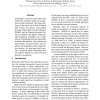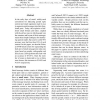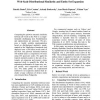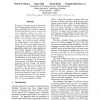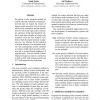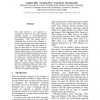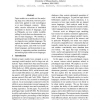EMNLP
2009
13 years 9 months ago
2009
Recent syntactic extensions of statistical translation models work with a synchronous context-free or tree-substitution grammar extracted from an automatically parsed parallel cor...
EMNLP
2009
13 years 9 months ago
2009
In this paper, we present a semi-supervised method for automatic speech act recognition in email and forums. The major challenge of this task is due to lack of labeled data in the...
EMNLP
2009
13 years 9 months ago
2009
In the early days of email, widely-used conventions for indicating quoted reply content and email signatures made it easy to segment email messages into their functional parts. To...
EMNLP
2009
13 years 9 months ago
2009
Computing the pairwise semantic similarity between all words on the Web is a computationally challenging task. Parallelization and optimizations are necessary. We propose a highly...
EMNLP
2009
13 years 9 months ago
2009
We report in this paper a way of doing Word Sense Disambiguation (WSD) that has its origin in multilingual MT and that is cognizant of the fact that parallel corpora, wordnets and...
EMNLP
2009
13 years 9 months ago
2009
We present a fully automatic method for content selection evaluation in summarization that does not require the creation of human model summaries. Our work capitalizes on the assu...
EMNLP
2009
13 years 9 months ago
2009
Untranslated words still constitute a major problem for Statistical Machine Translation (SMT), and current SMT systems are limited by the quantity of parallel training texts. Augm...
EMNLP
2009
13 years 9 months ago
2009
This paper presents a new approach to selecting the initial seed set using stratified sampling strategy in bootstrapping-based semi-supervised learning for semantic relation class...
EMNLP
2009
13 years 9 months ago
2009
Topic models are a useful tool for analyzing large text collections, but have previously been applied in only monolingual, or at most bilingual, contexts. Meanwhile, massive colle...
EMNLP
2009
13 years 9 months ago
2009
This work investigates design choices in modeling a discourse scheme for improving opinion polarity classification. For this, two diverse global inference paradigms are used: a su...

